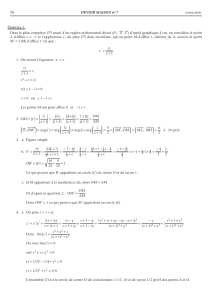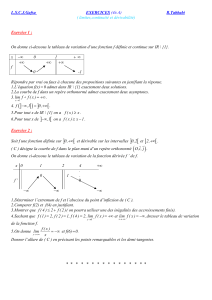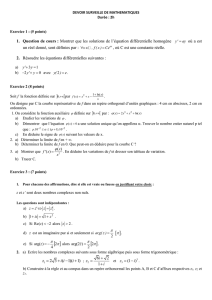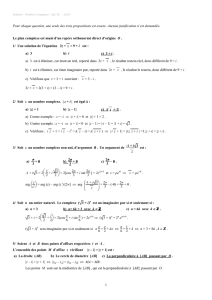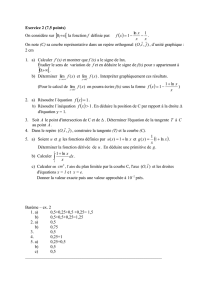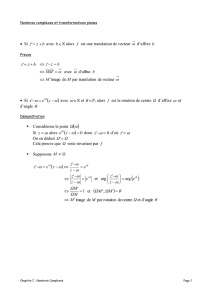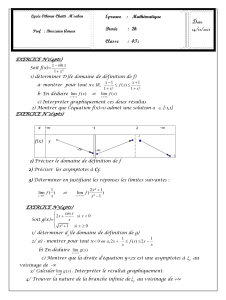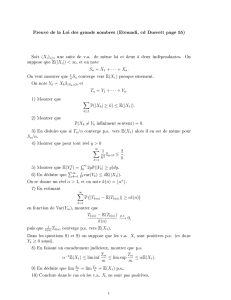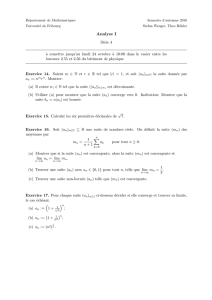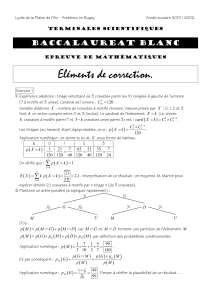2012 13 ts ds 5 complexes exponentielle
publicité
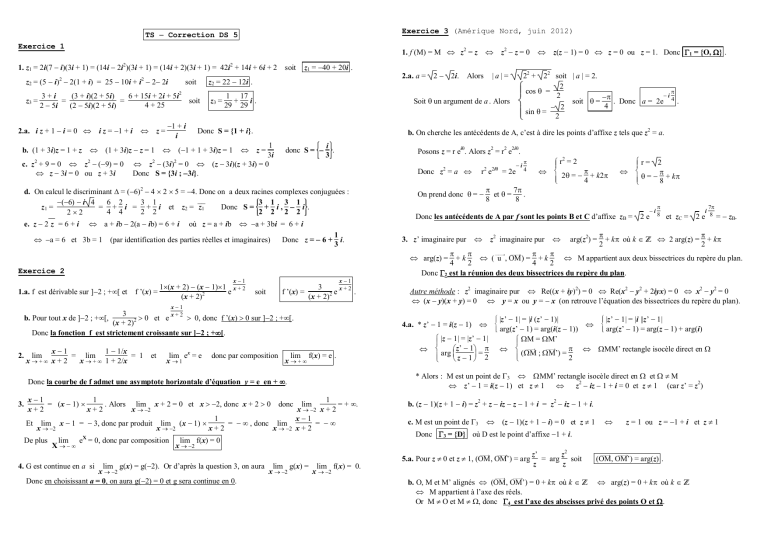
Exercice 3 (Amérique Nord, juin 2012)
TS Correction DS 5
Exercice 1
1. f (M) = M z2 = z z2 z = 0
2
2
1. z1 = 2i(7 i)(3i + 1) = (14i 2i )(3i + 1) = (14i + 2)(3i + 1) = 42i + 14i + 6i + 2 soit
2
2
z2 = (5 i) 2(1 + i) = 25 10i + i 2 2i
z3 =
b. (1 + 3i)z = 1 + z
2
z=
c. z + 9 = 0 z (9) = 0
z 3i = 0 ou z + 3i
z3 =
1 17
+
i.
29 29
Donc S = {1 + i}.
(1 + 1 + 3i)z = 1
a + ib 2(a ib) = 6 + i
22 + 22 soit | a | = 2.
cos = 2
i
2
soit =
. Donc a = 2e 4 .
4
2
sin = 2
|a |=
b. On cherche les antécédents de A, c’est à dire les points d’affixe z tels que z2 = a.
z=
donc S =
i
.
3
Posons z = r ei. Alors z2 = r2 e2i.
Donc z2 = a
d. On calcul le discriminant = (6)2 4 2 5 = 4. Donc on a deux racines complexes conjuguées :
3 1
(6) i 4
6 2
3 1
3 1
z1 =
= + i = + i et z2 = ¯¯
z1
Donc S = + i , i.
4 4
2 2
2
2
2 2
22
e. z 2 z = 6 + i
Alors
Soit un argument de a . Alors
1
3i
z2 (3i)2 = 0 (z 3i)(z + 3i) = 0
Donc S = {3i ; 3i}.
(1 + 3i)z z = 1
2
1 + i
i
2.a. a = 2 2i.
z2 = 22 12i .
soit
3+i
(3 + i)(2 + 5i)
6 + 15i + 2i + 5i2
=
=
soit
4 + 25
2 5i
(2 5i)(2 + 5i)
2.a. i z + 1 i = 0 i z = 1 + i
z1 = 40 + 20i .
z(z − 1) = 0 z = 0 ou z = 1. Donc 1 = {O, } .
où z = a + ib a + 3bi = 6 + i
1
Donc z = 6 + i.
3
a = 6 et 3b = 1 (par identification des parties réelles et imaginaires)
r2 e2i = 2e
On prend donc =
i
4
2
r = 2
2 = 4 + k2
r = 2
= 8 + k
7
et =
.
8
8
i
Donc les antécédents de A par f sont les points B et C d’affixe z B = 2 e
3. z’ imaginaire pur
z2 imaginaire pur
arg(z2) =
8
i
et zC = 2 e
7
8
= zB.
+ k où k 2 arg(z) = + k
2
2
+k
( u , OM) = + k
M appartient aux deux bissectrices du repère du plan.
4
2
4
2
Donc 2 est la réunion des deux bissectrices du repère du plan.
arg(z) =
Exercice 2
x 1
1.a. f est dérivable sur ]2 ; +[ et
f ’(x) =
1(x + 2) (x 1)1 x + 2
e
(x + 2)2
x 1
soit
f ’(x) =
3
x+2
e
.
(x + 2)2
Autre méthode : z2 imaginaire pur Re((x + iy)2) = 0 Re(x2 y2 + 2iyx) = 0 x2 y2 = 0
(x y)(x + y) = 0 y = x ou y = x (on retrouve l’équation des bissectrices du repère du plan).
x1
3
x+2
b. Pour tout x de ]2 ; +[,
0 et e
0, donc f ’(x) 0 sur ]2 ; +[.
(x + 2)2
Donc la fonction f est strictement croissante sur ]2 ; +[.
x1
1 1/x
2. lim
= lim
= 1 et
x + x + 2
x + 1 + 2/x
lim ex = e
x 1
donc par composition
4.a. * z’ 1 = i(z 1)
lim f(x) = e .
x +
x1
1
1
= (x 1)
. Alors lim x + 2 = 0 et x 2, donc x + 2 0 donc lim
= + .
x+2
x+2
x 2
x 2 x + 2
1
x1
Et lim x 1 = 3, donc par produit lim (x 1)
= , donc lim
=
x 2
x 2
x+2
x 2 x + 2
De plus
|z’ 1| = |i (z’ 1)|
|z’ 1| = |i ||z’ 1|
arg(z’ 1) = arg(i(z 1))
arg(z’ 1) = arg(z 1) + arg(i)
M = M’
MM’ rectangle isocèle direct en
(M ; M’) = 2
* Alors : M est un point de 3 MM’ rectangle isocèle direct en et M
z’ 1 = i(z 1) et z 1
z2 iz 1 + i = 0 et z 1 (car z’ = z2)
Donc la courbe de f admet une asymptote horizontale d’équation y = e en + .
3.
|z 1| = |z’ 1|
z’ 1
arg z 1 = 2
lim eX = 0, donc par composition lim f(x) = 0
X
x 2
b. (z 1)(z + 1 i) = z2 + z iz z 1 + i = z2 iz 1 + i.
c. M est un point de 3
(z 1)(z + 1 i) = 0 et z 1
5.a. Pour z 0 et z 1, (OM, OM’) = arg
4. G est continue en a si
lim g(x) = g(2). Or d’après la question 3, on aura
x 2
Donc en choisissant a = 0, on aura g(2) = 0 et g sera continue en 0.
lim g(x) =
x 2
z = 1 ou z = 1 + i et z 1
Donc 3 = {D} où D est le point d’affixe 1 + i.
lim f(x) = 0.
z’
z2
= arg soit
z
z
(OM, OM’) = arg(z) .
x 2
b. O, M et M’ alignés (OM, OM’) = 0 + k où k arg(z) = 0 + k où k
M appartient à l’axe des réels.
Or M O et M , donc 4 est l’axe des abscisses privé des points O et .
